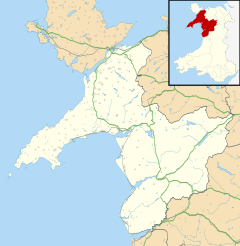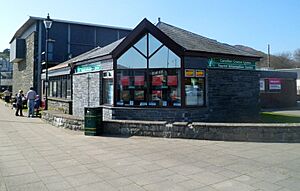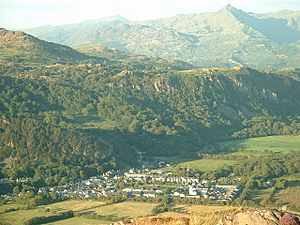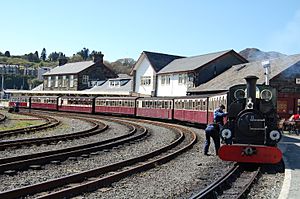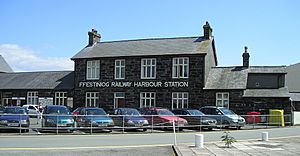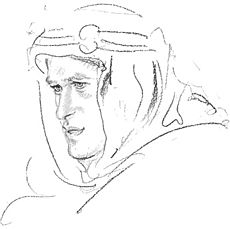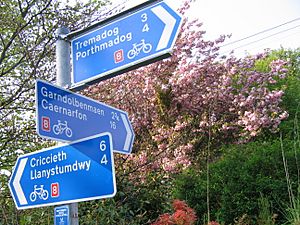Porthmadog facts for kids
Quick facts for kids Porthmadog |
|
|---|---|
 Porthmadog Harbour was developed to export slate |
|
| Area | 16.18 km2 (6.25 sq mi) |
| Population | 4,185 (2011) |
| • Density | 259/km2 (670/sq mi) |
| OS grid reference | SH565385 |
| Community |
|
| Principal area | |
| Ceremonial county | |
| Country | Wales |
| Sovereign state | United Kingdom |
| Post town | PORTHMADOG |
| Postcode district | LL49 |
| Dialling code | 01766 |
| Police | North Wales |
| Fire | North Wales |
| Ambulance | Welsh |
| EU Parliament | Wales |
| UK Parliament |
|
| Welsh Assembly |
|
Porthmadog (pronounced "porth-MAD-og"), often called "Port" by locals, is a lively coastal town in Gwynedd, Wales. It's located in the Eifionydd area, which was once part of the historic county of Caernarfonshire. The town is about 5 miles (8 km) east of Criccieth and 11 miles (18 km) south-west of Blaenau Ffestiniog.
In 2011, about 4,185 people lived here. Porthmadog grew a lot in the 1800s. It became a busy port for shipping slate from nearby quarries. When the slate trade slowed down, Porthmadog became a popular place for shopping and tourism. It's very close to Snowdonia National Park and the famous Ffestiniog Railway. The town also includes the nearby villages of Borth-y-Gest, Morfa Bychan, and Tremadog.
Contents
History of Porthmadog
Porthmadog exists because of a man named William Madocks. Between 1808 and 1811, he built a large sea wall called the Cob. This wall helped to reclaim a huge area of land, called Traeth Mawr, from the sea. This land was then used for farming.
Building the Cob also changed the path of the River Glaslyn. The river then carved out a new, deep natural harbour. This harbour was perfect for small ocean-going sailing ships. The first public docks were built in 1825. Soon, quarry companies built their own docks along the shore. Slate was brought from Ffestiniog to these docks. It was then loaded onto ships at Porthmadog.

In the late 1800s, Porthmadog became a very busy port. Its population grew from 885 people in 1821 to over 3,000 by 1861. Cities in England needed lots of good quality roofing slate. This slate was brought to Porthmadog by special railways from quarries in Ffestiniog and Llanfrothen.
The Ffestiniog Railway opened in 1836. Other railways like the Gorseddau Tramway (1856) and the Croesor Tramway (1864) followed. By 1873, over 116,000 tons of slate were shipped from Porthmadog. Many ships were built here too. Shipbuilders were famous for their three-masted schooners, called Western Ocean Yachts. The last one was launched in 1913.
By 1841, the main road across the reclaimed land became Stryd Fawr. This is the town's main shopping street today. It had many shops, pubs, and a post office. An industrial area also grew to the north. It had foundries, sawmills, and other factories.
Porthmadog's role as a busy port ended after the First World War. The important German market for slate disappeared. The old docks are still there, but the slate warehouses are now holiday apartments. The harbour is now used by leisure yachts.
What's in a Name?
The name Porthmadog comes from its older English spelling, Portmadoc. This was the official name until 1972. It combines "Port" with the name of William Madocks, who created the town. Some people believe it's named after a Welsh folklore character, Madog ab Owain Gwynedd.
The name "Port Madoc" first appeared in the 1820s. It was used when talking about ships. The name was first shown on an Ordnance Survey map in 1838.
How Porthmadog is Governed
Porthmadog has two main levels of local government. There's the town council, called Cyngor Tref Porthmadog. Then there's the larger county council, Cyngor Gwynedd. Both councils use Welsh as their main language. The town council meets at Y Ganolfan, a community centre near the harbour bridge. This building also has the town's tourist information centre.
Porthmadog is part of the Dwyfor Meirionnydd area for the UK Parliament. For the Welsh Parliament (Senedd), it's part of the Dwyfor-Meirionnydd area.
Geography and Nature
Porthmadog is located in Eifionydd, where the Afon Glaslyn flows into Tremadog Bay. This area is a great place for migrating birds. You can often see oystercatchers, redshanks, and curlews. In summer, flocks of sandwich terns visit. To the west of the town is Moel y Gest, a hill that rises 863 feet (263 meters) high.
The town has a mild, wet climate. This is because of the Gulf Stream, a warm ocean current.
| Month | Average high | Average low | Average precipitation |
| January | 8.0 °C | 3.0 °C | 8.38 cm |
| February | 8.0 °C | 3.0 °C | 5.59 cm |
| March | 9.0 °C | 4.0 °C | 6.60 cm |
| April | 11.0 °C | 5.0 °C | 5.33 cm |
| May | 14.0 °C | 8.0 °C | 4.83 cm |
| June | 17.0 °C | 10.0 °C | 5.33 cm |
| July | 18.0 °C | 12.0 °C | 5.33 cm |
| August | 19.0 °C | 12.0 °C | 7.37 cm |
| September | 17.0 °C | 11.0 °C | 7.37 cm |
| October | 14.0 °C | 9.0 °C | 9.14 cm |
| November | 11.0 °C | 6.0 °C | 9.91 cm |
| December | 9.0 °C | 4.0 °C | 9.40 cm |
Nearby Villages
Borth-y-Gest
Borth-y-Gest is about 1 mile (1.6 km) south of Porthmadog. It's a pretty village with a sheltered bay. In the past, ships were built here. Houses were built so pilots could watch for ships needing help. The village has many old Victorian houses.
Before Porthmadog was built, Borth-y-Gest was where people crossed the wide and dangerous Glaslyn estuary. Locals would guide travelers across the tricky sands to Harlech.
Parc y Borth is a nature reserve with old Welsh oaks. You might see green woodpeckers and pied flycatchers here. Pen y Banc is another nature reserve by the shore. It has rocks, sandy coves, and woodlands. It's a good place to see wading birds.
Morfa Bychan
Morfa Bychan is about 2.1 miles (3.4 km) south-west of Porthmadog. It has a wide beach called Black Rock Sands. At low tide, you can explore rock pools and caves. This beach is popular for windsurfing. It's also unusual because you can drive vehicles onto the sand.
Behind the beach are sand dunes. These are part of the Morfa Bychan and Greenacres Nature Reserve. You can also find an ancient stone monument called Cist Cerrig here.
Tremadog
Tremadog is a planned village about 0.9 miles (1.4 km) north of Porthmadog. It was also built on land reclaimed by William Madocks. The first cottages appeared in 1805. Madocks wanted it to feel like a small town, with a central Town Hall. There were also plans for factories powered by water.
To the north is Tan-yr-Allt, a property bought by Madocks. It has a memorial to the poet Percy Bysshe Shelley.
People and Population
In 2001, Porthmadog had 4,187 people. About 71% of residents were born in Wales. Most people (74.9%) in Porthmadog speak Welsh regularly. For young people aged 10–14, almost all (96.3%) speak Welsh.
| Year | 1801 | 1811 | 1821 | 1831 | 1841 | 1851 | 1861 | 1871 | 1881 |
| Population | 525 | 889 | 885 | 1,075 | 1,888 | 2,347 | 3,138 | 4,367 | 5,506 |
| Year | 1891 | 1901 | 1911 | 1921 | 1931 | 1939 | 1951 | 1961 | 2001 |
| Population | 5,224 | 4,883 | 4,445 | 4,184 | 3,986 | 4,618 | 4,061 | 3,960 | 4,187 |
| Year | 2011 | 2021 | |||||||
| Population | 4,185 | 3,970 |
Economy and Work
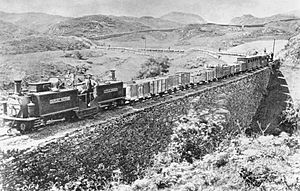
Porthmadog grew quickly because it was a port for exporting slate. Welsh slate was in high demand for building in English cities. It was brought to Porthmadog by horse-drawn railways. The Ffestiniog Railway opened in 1836. It was first a gravity railway, meaning empty slate wagons were pulled back up by horses. In 1863, it started using steam engines. Trains could go right onto the docks.
By 1873, 116,000 tons of slate were shipped from Porthmadog. Other types of trade also grew. The First World War ended Porthmadog's exports. No new ships were built, and many were sold. By 1925, very little slate was shipped by sea from Porthmadog. The last load of slate left by sea in 1946.
In the 1800s, several shipbuilders moved to Porthmadog. They built different types of sailing ships. After the railway arrived, trade changed. A new type of ship, the Western Ocean Yacht, was developed. These were used for the salt cod industry in Newfoundland and Labrador. Shipbuilding ended in 1913.
Porthmadog also had at least three iron foundries in the 19th century. The Britannia Foundry was very successful. It made machinery for slate quarries and railway equipment.
Culture and Community
Porthmadog is a strong Welsh-speaking community. Most activities are held in Welsh. The town hosted the National Eisteddfod in 1987. This is a big festival of Welsh culture, music, and poetry.
Y Ganolfan on Stryd Fawr is a place for concerts and exhibitions. It was built in 1975. The Porthmadog Maritime Museum is on Oakley Wharf. It's in an old slate shed. It shows displays about the schooners built in the town and the sailors who worked on them.
Famous Landmarks
- The Cob is a large embankment built across the Glaslyn estuary in 1811. William Madocks built it to reclaim land for farming. It also created a roadway connecting Caernarfonshire to Meirionnydd. The Ffestiniog Railway later built its line across the Cob. This made it the main route for slate to reach Porthmadog. The toll to cross the Cob was removed in 2003.
- Pen Cei, west of the harbour, was the centre of the town's shipping business. Boats were built and repaired here. Each quarry company had its own slate docks.
- Melin Yr Wyddfa ("Snowdon Mill") is an old flour mill built in 1862. It is now being turned into flats.
- The Welsh Highland Heritage Railway is a short heritage railway. It has a miniature railway, a heritage centre, and a shop.
- Kerfoots is a small department store on Stryd Fawr. It's in a Victorian building and was founded in 1874. It has a unique spiral staircase and stained glass dome.
- The Royal Sportsman Hotel was built in 1862. It was a stop for coaches on the road to Porthdinllaen. When the railway arrived, more tourists came. The hotel became famous for taking guests to local sights.
- The War Memorial stands on Ynys Galch, one of the islands reclaimed from Traeth Mawr. It's a Celtic cross made of granite. It was unveiled in 1922 to remember local war heroes.
- On Moel y Gest, a hill above the town, there is an Iron Age hill fort.
Education in Porthmadog
Porthmadog has three local primary schools:
- Ysgol Eifion Wyn is a bilingual school in Stryd Fawr. It has about 204 pupils. It moved to new buildings in 2003.
- Ysgol Borth-y-Gest in Stryd Mersey, Borth-y-Gest, is the smallest with 70 pupils. It was built in 1880.
- Ysgol y Gorlan in Tremadog has 122 pupils.
Ysgol Eifionydd in Stryd Fawr is a bilingual secondary school for ages 11–16. It was founded around 1900 and has 484 pupils.
Getting Around Porthmadog
Porthmadog is on the A487 main road. This road connects Fishguard and Bangor. The A498 goes north from Porthmadog to Beddgelert, leading to Snowdonia. The A497 goes west to Criccieth and Pwllheli. A bypass for Porthmadog opened in 2011 to help reduce traffic through the town.
The town has three railway stations:
- Porthmadog is on the Cambrian Coast Line. You can catch trains here to places like Shrewsbury and Birmingham.
- Porthmadog Harbour is the end station for the Ffestiniog Railway. This railway has been running passenger services since 1865. Since 2011, it's also the southern end of the rebuilt Welsh Highland Railway from Caernarfon.
- The Welsh Highland Heritage Railway has its main station near the north end of Stryd Fawr.
Buses also run from Porthmadog to many nearby towns and villages.
Famous People from Porthmadog
- Rob Piercy (born 1946) is a local artist. He was named Welsh Artist of the Year in 2002.
- Elfyn Lewis (born 1969) is a painter from Porthmadog. He won a Gold Medal for fine art in 2009.
- The Welsh singer Duffy (born 1984) filmed her first music video, "Rockferry", in the town.
- The band Supergrass filmed a video at Morfa Bychan and Portmeirion for their song "Alright".
- David Owen (1712–1741) was a blind harpist and composer from Morfa Bychan. He wrote the famous Welsh tune Dafydd y Garreg Wen.
- The poet William Ambrose (1813–1873) was a minister in the town.
- The poet R. S. Thomas (1913–2000) is buried in St John's Churchyard.
- T. E. Lawrence (1888–1935), known as Lawrence of Arabia, was born in Tremadog. He was famous for his role in the Arab Revolt.
- The poet Percy Bysshe Shelley (1792–1822) lived in Tremadog for a time. He wrote his poem Queen Mab while living there.
- The Spooner family helped develop railways in the area for over 70 years in the 1800s.
- Mason Ryan (born 1982), a WWE wrestler, is from the area.
Sports and Activities
- Porthmadog Football Club was founded in 1872. It's one of the oldest football clubs in Wales. They play at Y Traeth.
- Clwb Rygbi Porthmadog is the town's rugby union club. They play at Clwb Chwaraeon Madog.
- Porthmadog Golf Club at Morfa Bychan opened in 1906. It has a mix of heathland and links course styles.
- Porthmadog Sailing Club started in 1958. They hold weekend dinghy races.
- Madoc Yacht Club was founded in 1970. They have a busy program of cruising and racing. They also have a sea-rowing section.
- Glaslyn Leisure Centre has a swimming pool, sports hall, and courts for badminton, squash, and tennis.
- Sea angling is popular in the coastal villages. You can catch fish like flounder, bass, and mackerel.
- The Glaslyn Angling Association manages fishing rights on most of the Afon Glaslyn. You can find sea trout, salmon, and brown trout here.
- A cycle route crosses the Cob. It's part of Lôn Las Cymru, the Welsh national cycle route. This route is 250 miles (400 km) long.
- Rock climbing is popular in Tremadog. The cliffs are often dry, even when it's wet in Snowdonia. Craig Bwlch y Moch is a famous climbing spot.
- A fell race called "Râs Moel y Gest" is held each year on the slopes of Moel y Gest.
- Bathing is popular at Black Rock Sands, which has excellent water quality. Borth-y-Gest also has a safe beach for swimming close to shore.
Twin Town
Porthmadog is twinned with:
See also
 In Spanish: Porthmadog para niños
In Spanish: Porthmadog para niños


